| Published
on 3
Nov
2022 |
All rights reserved.
|
|
|
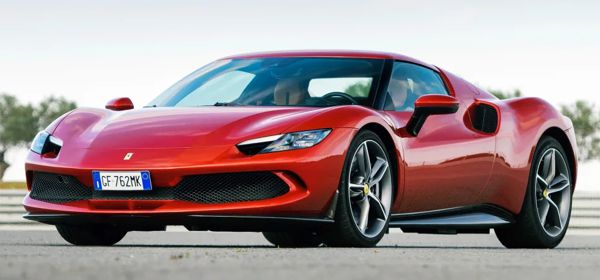 |
|
"New
Dino" turns out to be the successor of F8, does it deserve the place?
|
|
When spy photos and rumors
leaked all over the internet, we thought the new Ferrari under testing
was to be a new Dino, i.e. an entry-level mid-engined Ferrari. Somehow,
it turned out to be the successor of F8 Tributo or a decontented SF90
Stradale. Although Ferrari still lists the F8 on its website and
declines to confirm its replacement by the 296 GTB, the market
positioning and the launch timing imply so. The 296 GTB offers slightly
higher performance than the F8. It costs slightly more as well,
starting at £242,000, which makes it noticeably more expensive
than Lamborghini Huracan and McLaren Artura.
The new car is smaller than the F8, but just marginally. It is 46 mm
shorter, 21 mm narrower and 19 mm lower, while wheelbase is cut by 50
mm to 2600 mm. This is made possible by switching from V8 to V6 plug-in
hybrid power.
Hybrid Powertrain
The name 296 is a bit misleading, because its V6 engine displaces 3.0
liters, or more precisely 2992 cc. Downsizing from 8 to 6 cylinders and
from 3.9 to 3.0 liters might raise some eyebrows, but it is an
industrial trend not even the production Ferrari could escape from.
Adding
PHEV function can compensate the loss of power while fooling the
current emission regulations. But how about emotion, especially sound
quality? We'll see soon.
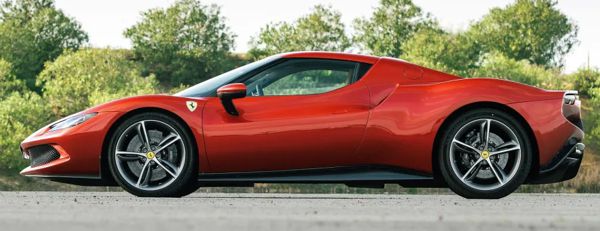 |
|
The
proportion and silhouette remind me another Italian design classic:
Alfa Romeo Tipo 33 Stradale.
|
|
Maranello’s F163 V6 has no relationship with Alfa Romeo's 2.9-liter
unit or Maserati's 3.0-liter Nettuno V6. This can be seen from its
wider, 120-degree V-angle, whereas those V6s are 90-degree.
Interestingly, McLaren also opted for exactly the same configuration
for its Artura. A 120-degree V6 not only lowers center of gravity but
also provides plenty of space for installing the 2 turbos inside the V,
a solution previously only possible on engines with smaller turbos and
lower specific output. By relocating the turbos from the sides to the
inside of the V not only makes the powertrain more compact, but it
offers other benefits as well. The first is shorter ducts which reduces
turbo lag and quickens throttle response. The second is a more
straightforward exhaust arrangement, as the exhaust manifolds can go
straight to a single exhaust at the tail, reducing back pressure. The
third is lighter weight. This takes some explanation...
Ferrari has always been using cast aluminum intake plenum on its
production models for cosmetic reasons. A thermoplastic intake plenum
is lighter, but it looks cheap and ugly, especially as the centrally
located intake plenum always takes the center stage when you look at
the engine bay. By exchanging the position of turbos and intakes now,
you can no longer see the intake plenums. That's why Ferrari can switch
to thermoplastic ones. What you see when open the glass engine lid is
a pair of thin metal shield that protects against touching the turbos,
but it works so well pretending an intake plenum.
The V6 shares its oversquared combusion chamber dimensions (88 mm bore,
82 mm stroke) with the 4-liter V8 of SF90 Stradale. It runs 9.4:1
compression ratio, lower than the 11.0:1 figure of Maserati Nettuno, as
it lacks the latter's pre-chamber combustion technology.
However, it still employs 350-bar direct injection, centrally located
fuel injectors and spark plugs and turbulence-enhancing intake ducts to
improve air-fuel mixing. The turbos are an improvement from both the F8
and SF90, as they use higher strength alloy to enable smaller yet
faster spinning (up to 180,000 rpm) turbines. This means they can
provide very high
boost pressure (2.4 bar) yet reduce rotating inertia by 11 percent,
hence less turbo lag.
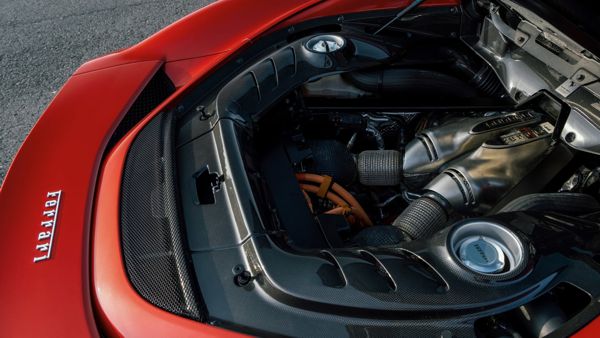 |
|
What
you see is a pair of thin metal shield that protects against touching
the turbos, but it works so well pretending an intake plenum.
|
|
As a result, the F163 breaks production engine records for specific
output. It produces 663 horsepower at 8000 rpm, more than either the
Maserati (630 hp) or McLaren (585 hp). It can spin to 8500 rpm, 500 rpm
higher than the existing V8. Maximum torque of 546 lbft is slightly
higher than those rivals as well, although Ferrari configures
its engine to release full torque only at higher revs and gears, so to
provide a linear character.
And then the hybrid system. While SF90 employs 2 front motors and a
rear motor, the 296 GTB ditches the former for simplicity and lighter
weight. Only a disc-shape axle flux motor is adopted between the
engine and 8-speed DCT gearbox. It is supplied by a 7.4 kWh lithium
battery located on the floor just behind the seats. The electric motor
offers 167 hp and 232 lbft of torque. A clutch can disconnect the
engine and allow the car to run in EV mode, which can travel just 25 km
(15.5 miles) and at speeds up to 84 mph. These figures match those of
the McLaren, which uses a battery of the same size.
The combined output is 830 horsepower, 110 hp higher than F8 and 150 hp
more than
McLaren Artura. That's why it quotes much higher performance. Its 0-60
mph time of 2.8 seconds matches that of F8 and reflects more about the
limits of its rear wheel traction. However, 0-124 mph is accomplished
in 7.3 seconds, half a second quicker than the F8. Top speed is lowered
from 211 to 205 mph, implying the electric motor stops working at
top-speed run. Still, the electric boost allows the 296 GTB to lap
Fiorano track in 1:21, or 1.5 second quicker than the F8, even though
it carries an extra 140 kg thanks to the hybrid hardware.
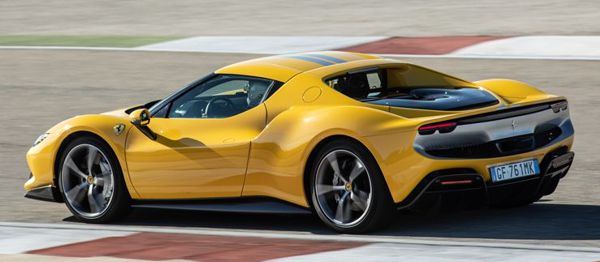 |
|
It
produces 150 hp more than a McLaren Artura, and this reflects on
performance stats.
|
|
Chassis
The improvement of real-world performance is not only down to enhanced
power but also better handling. Despite carrying more weight, the
center of gravity is made 10 mm lower than that of the F8, thanks to
the wide-angle engine as well as the low placement of battery. Braking
performance from the standard Brembo ceramic brakes is also improved,
taking 9 percent shorter distance
to stop from 124 mph. This is contributed by cooling ducts on brake
calipers and the
switch to by-wire braking system which works with the new 6W-CDS (6-way
chassis dynamics sensor) system. The latter provides acceleration and
speed data in 3 axis to various electronic driving aids,
including ABS.
Aerodynamics is also improved. The 296 GTB has a smaller frontal area
as it is slightly lower and narrower than the F8. It features an active
rear spoiler which raises to add 100 kg downforce. A panel bridging the
top of flying buttresses guides the air stream from the roof straight
to the rear spoiler, reducing drag and optimizing downforce. Overall,
the car generates 360 kg of downforce at 155 mph when track-oriented
Assetto Fiorano package is equipped.
The chassis is predictably an aluminum spaceframe, bodied in
aluminum. Suspension continues to be double-wishbone up front and
multi-link at the rear, supported with magnetorheological adaptive
dampers. The gearbox remains Getrag dual-cutch transmission, although
now sports 8 forward
ratios. The F8's electrohydraulic steering has been replaced with new
electrical
power steering, but it remains fixed ratio and high-geared for very
quick response. Unlike Porsche or Lamborghini, Ferrari considers
rear-wheel steering unnecessary for the car, especially when it already
has E-Diff and Side Slip Control.
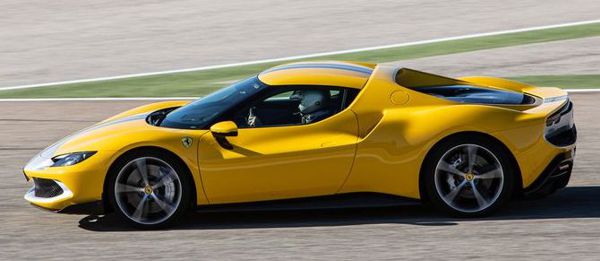 |
|
The
closer it approaches the 8500 rpm redline, the closer it sounds like a
V12.
|
|
At 1470 kg dry (about 1580 kg with fluid), the 296 GTB is 100 kg
lighter than
SF90 Stradale but 140 kg heavier than F8. It is also a little heavier
than the hybrid McLaren Artura, which employs carbon-fiber chassis.
Note
that this number already
has all lightweight options taken into account, including carbon-fiber
wheels and
track-oriented Assetto
Fiorano package. The latter includes polycarbonate engine lid instead
of the standard glass item, carbon-fiber inner door panels and carbon
shell racing buckets, as well as some aero tweaks to add downforce and
Multimatic
DSSV dampers instead of the standard adaptive dampers. It also replaces
the standard Michelin Pilot Sport 4S tires with semi-slick Cup 2 R.
Design
As for styling, the 296 GTB is the first departure from the theme set
by 458 Italia in 2009. It looks incredibly pure compared with its
predecessors,
even retro. Some inspiration is taken from the classic 250LM race car
of 1963, which is evident in the side intakes, the curvy rear fenders
and the aforementioned air guide above the flying buttresses. However,
the proportion and silhouette remind me another Italian design classic:
Alfa Romeo Tipo
33 Stradale. Like that car, its shoulder line is so
low, and the rear fenders are so dramatic. The shape of side windows
and B-pillars are remarkably close to that car as well.
The front end is slimmer and more tapered than the F8. The bonnet lacks
the latter's air outlets, but small intakes are added to the headlights
for cooling the brakes. The side view emphasizes a low-slung
proportion, as the top of door section is carved out to serve the
engine intake.
Unlike all its V8 predecessors since 360 Modena, the 296 GTB abandons
glass fastback design for classic flying buttresses and recessed engine
lid like the original Dino and subsequent models from 308 GTB to F355.
However, the engine lid is now made of curvy glass for displaying the
engine – even though there is not much engine to view – while a small
body-colored panel is added at the center, paying tribute to Testarossa
and F355. Overall, this is a beautiful and interesting design, perhaps
more retro than we used to see from Ferrari’s mid-engined sports cars.
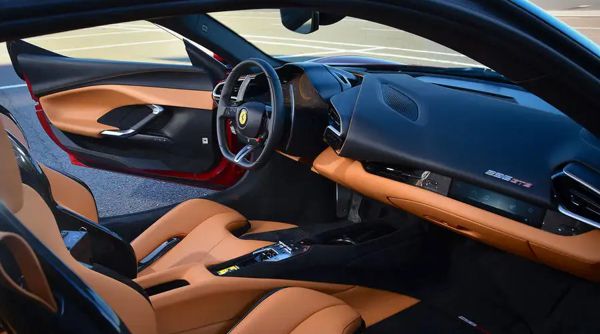 |
|
A
dedicated sound tube pumps the harmonics from the exhaust downstream to
the cabin.
|
|
On the Road
Open the door, you will find a cabin sharing much design and parts with
the SF90. It is spacious for a super sports car, has good view on the
road and to the sides, and rearward visibility through the vertical
screen is not bad either. Everywhere is trimmed with fine Italian
leather, giving a warmer and classier ambience than the Alcantara
choice of most rivals. The center console is obvious for its absence,
so there is no touchscreen to distract your attention. All information
is displayed on the 16-inch TFT instrument or HUD, and you can access
them through steering wheel controls or voice command – admittedly,
some touch-sensitive buttons could be troublesome.
The 296 GTB works well as a daily car. Not just its front luggage
compartment is generous by class standard, but its suspension is quite
comfortable in the softest mode. Road and wind noises are quite well
suppressed, too. The car starts silently with electric power. When
battery runs low or you ask for more power, the V6 fires up smoothly.
Ferrari blends the two power sources seamlessly. The electric power is
also used to fill the gap between gears, so the power delivery is
incredibly smooth and relentless. Consequently, throttle response is
immediate, while turbo lag is non-existent. It feels like a large
naturally aspirated V12, just with superior torque that pushes you hard
to the backrest in full bore acceleration. It will pull strongly from
2000 rpm at 6th gear, so you don’t need to bother with gearshift.
Whenever you need punch, it gives you immediately.
The V6 spins like a V12, too. It loves to rev and rev and rewards you
with great sound. At lower revs, it sounds no more special than a
Nissan GT-R. However, as rev rises, the exhaust note grows and takes
over from the induction noise. It is a high-pitched noise that differs
from any of its V8 predecessors. Because Ferrari opts for a symmetrical
firing order (1-6-3-4-2-5), the exhaust note mirrors a small V12. The
closer it approaches the 8500 rpm redline, the closer it sounds like a
V12. This is helped by a dedicated sound tube that pumps the harmonics
from the exhaust downstream (before entering catalytic converter) to
the cabin. The turbo whistles at each overrev adds to the sense of
occasion. This is easily the best sounding Ferrari turbocharged engine
to date.
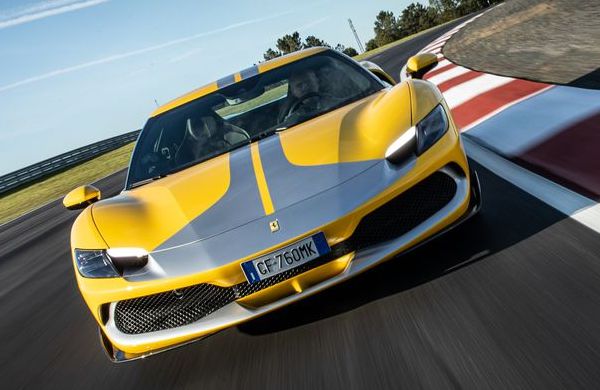 |
|
its
shorter wheelbase makes it shrink around you. You can drift it like a
Mazda MX-5...
|
|
The chassis is just as superb. Do you really feel the weight gain? I
doubt. The 296 GTB feels agile and just as responsive to steer as its
predecessor. If anything, its shorter wheelbase makes it more shrink
around you. The electrical power steering may not be overflowed with
feel, but it is even quicker than before yet feels more confidence
inspiring as it weighs up a little quicker. The by-wire braking feels
just as
smooth and natural as the best hydraulic brakes yet provides strong and
fade-free performance. The body control is flawless. Traction and grip
are abundance. All things come together so well that the car flows
through corner after corner. Best of all, the car balances remarkably
well. With traction control switched off, you can drift it like a Mazda
MX-5, adjust and hold the slide angle, just happens at double the
speed! That is also a testament how good its various electronic driving
aids are. They work invisibly behind the scene and not once catch you
abruptly.
Naturally, cars equipped with Assetto Fiorano pack is even stronger on
track, capable of faster cornering. However, its fixed rate dampers
aren’t as comfortable on road, and the racing buckets are too hard for
everyday use.
Some people have reservation about the SF90, whose 3-motor setup is
probably too powerful and complicated for the purists. The 296 GTB has
no such problems. Its steering does not suffer from corruption or
unpredictable response due to electric power. Its balance and handling
are just as natural as traditional Ferrari mid-engined cars. The
addition of hybrid power just irons out the weaknesses of turbocharged
engine and enhances the good old formula, making it faster, more
exciting and more absorbent. This car is nothing short of amazing.
|
Verdict:      |
|